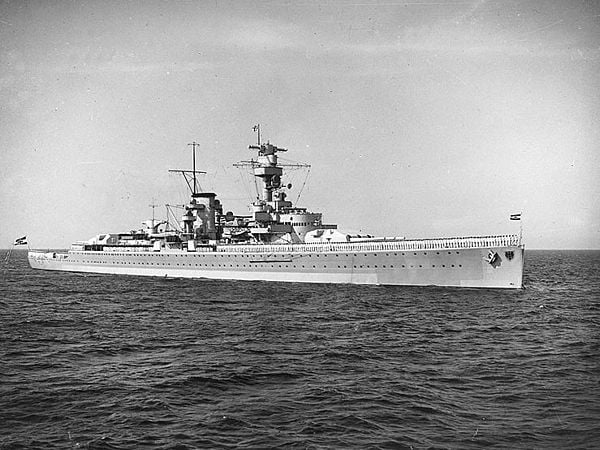The Deutschland was the first ship of a new type known as a Panzerschiff or armored ship, which the British called a pocket battleship. During the Civil War, the Deutschland conducted several non-intervention patrols off the coast of Spain. But did you know why Hitler changed the name of this particular Battleship?
In 1940, Hitler decided to rename the battle cruiser “Deutschland” to “Lützow,” recognizing that sinking a warship with the name of its country was a PR disaster.
The Deutschland or The Lutzwig
Deutschland was the lead ship in her class of heavy cruisers that served with Nazi Germany’s Kriegsmarine during World War II.
The Reichsmarine ordered Deutschland from the Deutsche Werke shipyard in Kiel as a replacement for the old pre-dreadnought battleship Preussen.
She was renamed Lützow in 1940 after the Soviet Union purchased the unfinished Admiral Hipper-class heavy cruiser Lützow the previous year.
Originally classified as an armored ship or the Panzerschiff by the Reichsmarine, the Germans reclassified the remaining two ships in this class as heavy cruisers in February 1940.
Her keel was laid on February 5, 1929,[4] with the construction number 219. On May 19, 1931, the ship was christened by German Chancellor Heinrich Brüning.
While Brüning was giving his christening speech, the ship began to slide down the slipway by accident. Initial sea trials began in November 1932, following the completion of the fit-out work. On April 1, 1933, the ship was commissioned into the Reichsmarine.
The majority of 1933 and 1934 were spent conducting training maneuvers; early speed trials in May 1933 suggested that a top speed of 25 knots or 46 km/h; 29 mph was preferable, but the ship comfortably reached 28 knots or 52 km/h; 32 mph on speed trials in June.
By December 1933, the ship’s trials had been completed, and it was ready for active service with the fleet. The boat also made several goodwill visits to foreign ports, including Gothenburg, Sweden, and a formal state visit to Edinburgh, Scotland, in October 1934. Adolf Hitler visited the ship in April 1934; he reportedly toured the boat alone, speaking informally with crew members.
(Source: WW2 Ships)
The Sunking of the Lutzow
Lützow returned to Norway to join forces opposing Allied shipping to the Soviet Union. She ran aground during a planned attack on convoy PQ 17, forcing her to return to Germany for repairs. She then fought alongside the heavy cruiser Admiral Hipper in the Battle of the Barents Sea, where she failed to destroy the convoy JW 51B.
Engine problems necessitated a series of repairs that culminated in a total overhaul at the end of 1943, after which the ship remained in the Baltic. Lützow was sunk in shallow waters in the Kaiserfahrt in April 1945 by Royal Air Force (RAF) bombers and used as a gun battery to support German troops fighting the Soviet Army until her crew disabled her on 4 May 1945. She was raised by the Soviet Navy in 1947 and later sunk as a target in the Baltic. (Source: The First News)
